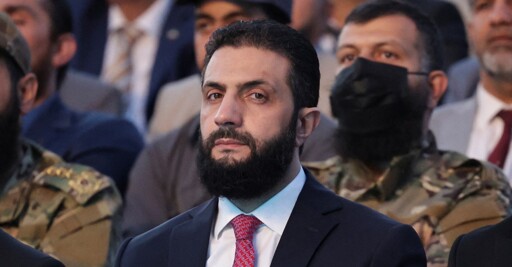Once again, images of horrifying violence are pouring out of Syria: dead bodies piled up in a hospital corridor. Gunmen calling out insults as they drive their cars over the corpses of murdered civilians.
These are not the first sectarian massacres in the seven turbulent months since the fall of Bashar al-Assad’s regime. But they represent something different, and not just because they led to a dramatic Israeli bombardment of Syria’s Defense Ministry on Wednesday that sent huge clouds of smoke billowing over central Damascus.
The latest intercommunal violence, which has left some 600 people dead in Syria’s southern province of Sweida, illustrates a fundamental disagreement between the United States and Israel over the nature of the Syrian state. Washington has been pushing for a strong central government in Damascus, but its closest ally in the region fears Syria’s new leaders, and has bolstered their domestic rivals.
The killings began just days after Thomas Barrack, President Donald Trump’s special envoy to Syria (and the U.S. ambassador to Turkey) laid out a muscular vision for a centralized Syria. “What we’ve learned is federalism doesn’t work,” Barrack said after meeting with Syria’s new president, Ahmed al-Sharaa. This was a startling rebuke to those who have argued for years that Syria should avert another dictatorship by conferring greater power on local authorities. Barrack made clear that he wants the Kurdish-led enclave in northeastern Syria—which has been holding out for more autonomy, like the Druze in the country’s south—to make larger concessions to Sharaa. “There is only one road, and it leads to Damascus,” Barrack said.
[Read: Can one man hold Syria together?]
That is not the Israelis’ view. Although they were happy to be rid of Assad, a sworn enemy, the Israelis do not trust Sharaa, a former jihadist whose forces swept to power in December, and who was once the leader of the Syrian branch of al-Qaeda. The Israelis have often seemed to believe that they are safer when their Arab neighbors are too weak and divided to pose a threat. That perspective may have motivated recent Israeli demands that southern Syria remain a demilitarized zone. The Israelis also have a special relationship with the Druze, historically a warrior community that lives both in Israel and across the border in Sweida, their stronghold.
Barrack’s comments, on July 9, may have suggested a kind of carte blanche to Sharaa: Do what you have to do to get the country’s troublesome minorities in line. Sharaa knew that the Israelis did not want him to send troops into Sweida. But for weeks, he had engaged in back-channel talks with Israel, in an American-sponsored effort to resolve decades of tensions over a host of issues. Perhaps Sharaa assumed that the Israelis and the Americans had worked out the differences in their positions toward him.
If so, he was wrong. On July 13, when small-scale fighting broke out in Sweida between local Bedouin and Druze men, Sharaa sent a large contingent of fighters southward from Damascus in aging tanks and pickup trucks. Their ostensible mission was to restore order, but Druze militia leaders mobilized, convinced that Sharaa’s real goal was to crush them and assert full control over Sweida.
Things turned ugly very quickly, just as they had in two previous outbreaks of sectarian murder, in March and May, and for the same reasons. Sharaa was able to defeat the Assad regime in December with the help of a loose coalition of undisciplined Islamist militias, many of them veterans of the long struggle against Damascus. Among these men are many violent extremists who consider Syria’s minorities—including Alawites and Christians, as well as Druze and Kurds—to be heretics.
As in the previous violent episodes this spring, the militias were joined by rifle-toting young men from across Syria, who could be seen in handheld videos, calling for the murder of heretics as they jumped into pickups and headed south. Government-aligned channels on Telegram and other platforms were full of rhetoric so viciously sectarian that it could make anyone despair about Syria’s future.
Sharaa’s cleanup operation in Sweida soon turned into a bloody clash between Sunni and Druze gunmen. One local Druze man told me on Tuesday that artillery was raining down on the provincial capital, and that kidnappings and gun battles were taking place across the area. One of the most prominent Druze spiritual leaders, Sheikh Hikmat al-Hijri, recorded a dramatic video in which he declared, “We are being subjected to a comprehensive war of extermination.” Hijri also broke an old taboo by calling for help from Israel and any other power willing to rescue the Druze.
Making matters worse, some Druze men in Israel began flooding the border to aid their co-religionists in Syria. That prompted Benjamin Netanyahu, Israel’s prime minister, to record a video telling the Israeli Druze not to cross into Syria, saying that Israeli forces were “acting to save our Druze brothers and to eliminate the gangs of the regime.”
The Israeli military soon made good on that threat, carrying out dozens of air strikes in Sweida and—more shocking—in central Damascus, where it struck near the presidential palace and hit the compound of the Defense Ministry.
The Israeli strikes got everyone’s attention. Secretary of State Marco Rubio, who was in the Oval Office with President Trump and a visiting Bahraini royal, told reporters that the bombing arose from “a misunderstanding, it looks like, between the Israeli side and the Syrian side.”
But if there was a misunderstanding, it originated at least partly with the U.S. president. Although Trump didn’t pay much attention to Syria in the first months of the year, he seems to have taken notice after meeting Sharaa in Riyadh in May. The leaders of Turkey and the Gulf States had already urged him to embrace Sharaa and drop the sanctions that have long strangled Syria’s economy. Trump quickly complied, and added a personal touch: Sharaa, he said, is an “attractive, tough guy” with a “strong past.”
[Read: The honeymoon is ending in Syria]
In other words, Sharaa looks to be Trump’s favorite kind of leader: a strongman. Barrack has been repeating Trump’s message and amplifying it ever since. He has compared Sharaa to George Washington, and even dropped hints that if Lebanon doesn’t clean up its own act soon, it could end up getting absorbed into a greater Syria. That is an odd way to talk about a country that remains shattered after many years of civil war, and where the government—desperately short on money and qualified people—is struggling to rebuild a national army.
Trump’s decision to give Sharaa his full support isn’t necessarily wrong. A unified Syrian state is what the country’s Sunni Muslim majority wants, and it is what the most influential regional powers—Turkey and Saudi Arabia—prefer. Some sort of compromise could possibly be worked out on the question of federal and local authority over the coming months and years, if Sharaa and the leaders of Syria’s minority communities are willing to be flexible.
But that would require Israel to be flexible too. If Israel keeps lobbing bombs at Syria, the prospects for peace along their border could evaporate, and with it the quiet diplomacy the Trump administration has pursued between the two countries. Sharaa’s attitude seemed already to be shifting in a televised speech he gave yesterday, in which he lashed out at Israel for the first time since he assumed power.
More than diplomacy is at stake. After three terrible waves of sectarian bloodletting in recent months, many in Syria’s minority communities have started to conclude that the state Sharaa envisions will—despite his regular protestations about pluralism and tolerance—be a place where they are not welcome. Thousands of them have already fled the country.
Trump and Barrack can say what they like about Sharaa being Syria’s George Washington. But if they do not press him harder to restrain the sectarian thugs in his own ranks, he may turn out to be a lot more like Saddam Hussein.
From The Atlantic via this RSS feed


